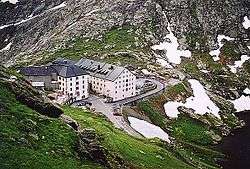Great St Bernard Hospice



The Great St Bernard Hospice is a hospice or hostel for travellers in Switzerland, at 2469m altitude at the Great St Bernard Pass in the Pennine Alps. The border with Italy is only a few hundred metres to the south.
History
The first hospice or monastery was the 9th century one at Bourg-Saint-Pierre mentioned for the first time around 812-820. This was destroyed by Saracen incursions in the mid-10th century, probably in 940, the date at which they also occupied Saint-Maurice. Around 1050, Saint Bernard of Menthon, archdeacon of Aosta, regularly saw travellers arriving terrorised and distressed, so he decided to put an end to mountain brigandage in the area. With this in mind, he founded the hospice at the pass which later bore his name (it was originally dedicated to St Nicholas). The church's first textual mention is in a document of 1125. The hospice was placed under the jurisdiction of the bishop of Sion, prefect and count of Valais, thus explaining why the whole pass is now in Swiss territory.
Dogs
The St. Bernard dog breed was created at the hospice from cross-breeding dogs, probably those offered by families in Valais in the 1660s and 1670s. The first definite mention of the breed is in 1709. The breed was originally raised to provide guard dogs for the hospice, before they became mountain rescue dogs. The St. Bernards were specially bred and trained for the role of mountain rescue because they were sufficiently strong to cross deep snow drifts and had the capacity to track lost travelers by scent. The first evidence that the dogs were in use at the monastery is in two paintings dating to 1690 by Salvatore Rosa.
The attachment to their collar of small casks containing brandy appears to be a 19th-century myth.[1]
The last recorded rescue by one of the dogs was in 1955, although as late as 2004 eighteen of the animals were still kept at the Hospice for reasons of sentiment and tradition. In 2004, the breeding of the dogs was undertaken by the Barry foundation at Martigny, and the remaining St. Bernards were transferred there from the Hospice. They remain a tourist attraction, and a number of the animals are temporarily relocated from Martigny to the Hospice during the summer months.
Memorial
In June 1800, Napoleon Bonaparte ordered a monumental tomb to be built at the Hospice for Louis Desaix (killed at the battle of Marengo), even though Desaix had not crossed the Alps with the armée de réserve. His body rested at Milan from 1800 to 1805, when it was buried at the hospice in the presence of Berthier, representing the emperor. A commemorative monument set up there in a chapel was moved in 1829, so that Desaix now lies anonymous under an altar dedicated to Saint Faustina.
In Popular Culture
The monastery is the setting for one chapter in the 1857 Charles Dickens novel "Little Dorrit", wherein some cold travelers and their mules spend the night, and are compared to some frozen unidentified dead bodies in the mortuary, which had been recovered from the mountain by the Fathers. The dogs and some outlying refuge shelters maintained by the monks are also mentioned. Dickens visited the place and saw the mortuary in 1846, and described it in a letter to his friend John Forster dated 6 September 1846.
External links
Sources
- (French) Jean-Luc Rouiller, Le Valais par les dates : une chronologie des origines à nos jours, dans Annales valaisannes, 1999, p. 105, 106, 109.
- (French) Le Grand-Saint-Bernard (collectif), dans Les chanoines réguliers de Saint-Augustin en Valais, Bâle, 1997 (Helvetia sacra, IV/1)
- (French) Lucien Quaglia, La maison du Grand-Saint-Bernard des origines aux temps actuels, Martigny, 1972.
Coordinates: 45°52′08″N 7°10′14″E / 45.86889°N 7.17056°E
References
- Hyde, W. W., 'The Great St. Bernard Pass and its Hospice', in Isis, vol. 27, 1937, pp. 306–320, Available on JStor